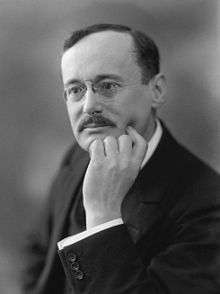Thomas Horder, 1st Baron Horder
Thomas Jeeves Horder, 1st Baron Horder, GCVO (7 January 1871 – 13 August 1955) was a British physician best known for his appointments as physician-in-ordinary to Kings Edward VII, Georges V and VI, and extra physician to Queen Elizabeth II. He was also the chosen physician of three prime ministers. He was knighted in 1918, made a baronet in 1923 and raised to the peerage in 1933.
The Lord Horder GCVO | |
|---|---|
 Horder in 1921 | |
| Member of the House of Lords Lord Temporal | |
| In office 23 January 1933 – 13 August 1955 Hereditary Peerage | |
| Preceded by | Peerage created |
| Succeeded by | The 2nd Lord Horder |
| Personal details | |
| Born | Thomas Jeeves Horder 7 January 1871 Shaftesbury, England |
| Died | 13 August 1955 (aged 84) Steep, England |
| Spouse(s) | Geraldine Doggett
( m. 1902; died 1954) |
| Alma mater | University of London |
| Occupation | Physician |
Biography
Early life and education

Thomas Jeeves Horder was born on 7 January 1871, the son of draper Albert Horder, in Shaftesbury, Dorset. Jeeves was his mother's maiden name. He was educated privately, and at the University of London and St Bartholomew's Hospital, London.[1]
Career
Horder began his career at St Bartholomew's Hospital, where his first junior post was under Samuel Gee.[2] When still quite young, Horder successfully made a difficult diagnosis on King Edward VII which made his reputation.[1] In 1908 he was appointed as the first physician to the Cancer Hospital, later known as the Royal Marsden Hospital.[3][4]
His patients included every British monarch from Edward VII to Elizabeth II (except Edward VIII).[1] They also included two prime ministers, Ramsay MacDonald and Bonar Law,[1] and labour leader Hugh Gaitskell.
He was involved in many official committees including advising the Ministry of Food during World War II.[1] After the war he opposed many of Aneurin Bevan's plans for a national health service and may have helped modify some of those less palatable to the medical profession.
He held the positions of Deputy Lieutenant County of Hampshire; Extra Physician to the Queen (formerly Extra Physician to King George VI); and Consulting Physician to St Bartholomew's Hospital (1912–1936). Knighted in 1918,[5] he was created a Baronet in 1923.[6] He was raised to the peerage as Baron Horder, of Ashford in the County of Southampton on 23 January 1933.[7]
Horder served as president of the British Eugenics Society from 1935 to 1949.[8][9] He was president of the Cremation Society of Great Britain from 1940 to his death in 1955.
He was president of The Peckham Experiment in 1949.[10]
Marriage and children
In 1902 Horder married Geraldine Rose Doggett (1872–1954),[1] of Newnham Manor, Hertfordshire, whose maternal grandfather was James Smith Rose of Arley House, Bristol, who in 1873 was the Mayor of Totnes. Their son was the publisher Mervyn Horder (1910–1997). Their daughter Joy Horder married Edward Cullinan, chief physician at St Bartholomew's Hospital; their son was British architect Edward Cullinan. d with abundant health and vitality to the end; he was succeeded in his title by his son.
Awards and honors
- 1918: Knight Bachelor[1]
- 1923: created Baronet of Shaston
- 1925: Knight Commander of the Royal Victorian Order[1][11]
- 1933: created 1st Baron Horder , of Ashford in the County of Southampton
- 1938: Knight Grand Cross of the Royal Victorian Order[12]
- Hon. DCL (Dunelm.)
- Hon. MD (Melbourne and Adelaide)[1]
Published works
- Clinical Pathology in Practice (Frowde, 1910)
- Cerebro-Spinal Fever (Hodder & Stoughton, 1915)
- Medical Notes (Hodder & Stoughton, 1921)
- The Essentials of Medical Diagnosis with A E Gow (Cassell & Co, 1928;)
- Health and a Day (Dent, 1938)
- Obscurantism (Watts & Co., 1938)
- Lessons Taught by War-time Feeding (1943)
- Rheumatism (H.K. Lewis & Co. Ltd., 1944)
- Diet and Rheumatism (1945)
- Health and Social Welfare annuals, editor, 1944–1945 and 1945–1946
- The British Encyclopaedia of Medical Practice, editor, 1950–1952
- Fifty Years of Medicine (Duckworth, 1953)
- Bread: The Chemistry and Nutrition of Flour and Bread with Sir Charles Dodds and T Moran (Constable, 1954)
References
- "Horder, Thomas Jeeves, first Baron Horder (1871–1955), physician". Oxford Dictionary of National Biography. doi:10.1093/ref:odnb/33985. Retrieved 13 June 2020.
- Trail, Richard R. "Thomas Jeeves Horder, Baron Horder of Ashford | RCP Museum". history.rcplondon.ac.uk. Archived from the original on 14 June 2020. Retrieved 14 June 2020.
- Hudson, Trevor. "Percy Ellis Thompson Hancock | RCP Museum". history.rcplondon.ac.uk. Archived from the original on 14 June 2020. Retrieved 14 June 2020.
- Walford, Edward. The county families of the United Kingdom; or, Royal manual of the titled and untitled aristocracy of England, Wales, Scotland, and Ireland. Dalcassian Publishing Company. p. 679.
- "No. 30607". The London Gazette. 2 April 1918. p. 4026.
- "No. 32849". The London Gazette. 31 July 1923. p. 5238.
- "No. 33905". The London Gazette. 24 January 1933. p. 521.
- Keynes, Milo (1993). Sir Francis Galton, FRS: The Legacy of His Ideas. Palgrave MacMillan. p. 228. ISBN 978-1-349-12208-0.
- Past presidents of the Galton Institute, Great Britain The Galton Institute, Great Britain, was formerly known as British Eugenics Society.
- "The Bulletin of the Pioneer Health Centre". Peckham. 1 (5). September 1949. Retrieved 21 October 2016.
- "No. 33067". The London Gazette. 17 July 1925. p. 4777.
- "No. 34469". The London Gazette (Supplement). 1 January 1938. p. 7.
Further reading
| Wikimedia Commons has media related to Thomas Horder, 1st Baron Horder. |
External links
| Peerage of the United Kingdom | ||
|---|---|---|
| Preceded by |
Baron Horder 1933–1955 |
Succeeded by Thomas Mervyn Horder |
| Baronetage of the United Kingdom | ||
| Preceded by |
Baronet (of Shaston) 1923–1955 |
Succeeded by Thomas Mervyn Horder |